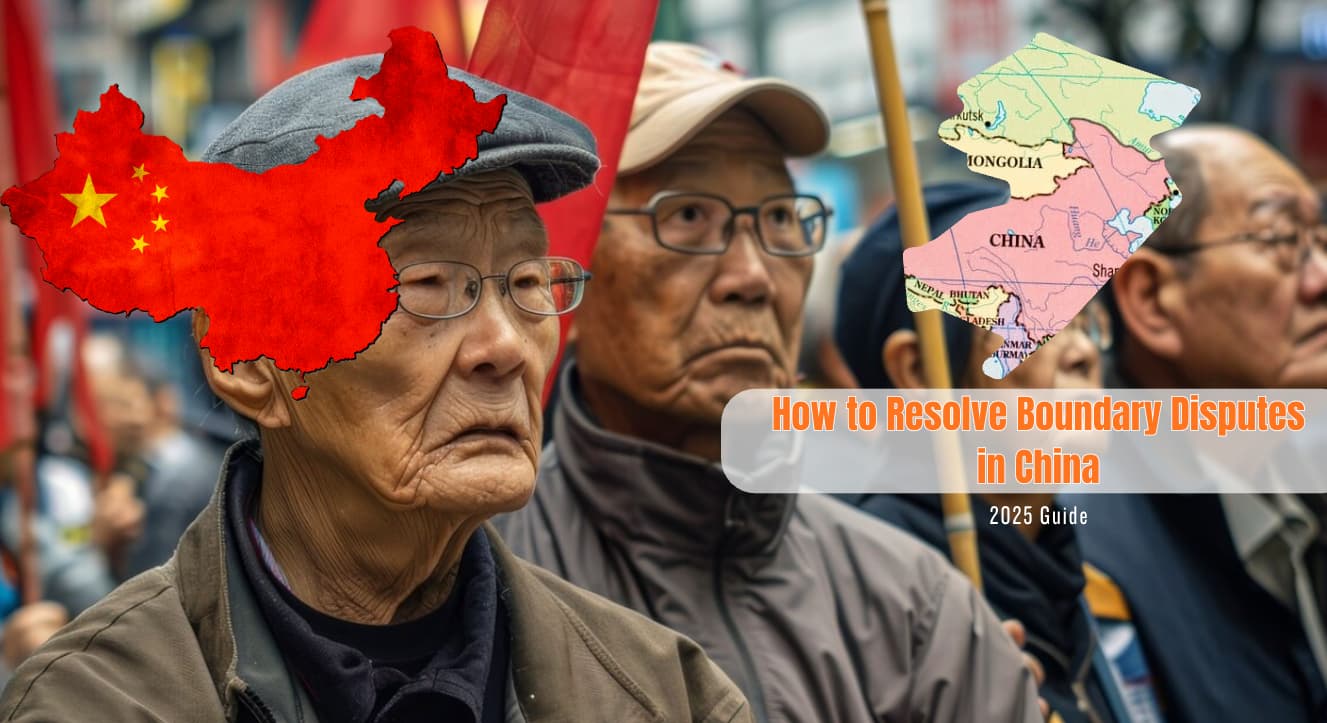In China, a line on paper can spark heated arguments in real life. From fences that creep across a yard to trees leaning over a neighbor’s wall, boundary disputes are among the most common property conflicts. They are stressful, but they are also solvable.
This 2025 guide to boundary disputes in China provides an overview of the legal framework, practical steps, and available forums for resolving them.
Whether you are a city homeowner dealing with encroaching walls or a rural resident facing collective land overlaps, knowing the right process can save you time, money, and energy.
Quick Takeaways:
- Most neighbor boundary disputes are governed by the PRC Civil Code and real estate registration rules.
- Start with discussion or people’s mediation, then escalate to administrative handling, arbitration, or court litigation.
- In China, you hold land use rights recorded in the real estate registry, not outright land ownership.
- The new Rural Collective Economic Organizations Law (2025) strengthens collective decision-making for rural land issues.
- Your best defense is a clean file: real estate certificates, cadastral maps, licensed survey reports, photos, and dated notices.
👉 Also Read: Permanent Residence in China Application
Why Do Boundary Disputes Happen in China?

Boundary disputes in China are complex legal issues that can arise from historical, administrative, or construction-related factors.
Understanding the most common causes helps property owners, developers, and residents recognize potential problems early and take steps to protect their land rights.
Below are the primary reasons why boundary disputes occur in China:
1. Unclear Land Titles and Registration Issues
One of the most frequent causes of boundary disputes in China involves unclear or incomplete land titles.
Many older properties, especially in rural areas, lack official cadastral maps or proper registration documents. This makes it difficult to determine exact property lines and legal ownership.
Key factors:
- Older properties may have been transferred or divided informally without government documentation
- Rural land often relies on verbal agreements or traditional family understandings rather than official surveys
- Historical records may be missing, damaged, or inconsistent with current land use
- New mapping technology and government surveys can reveal discrepancies between recorded boundaries and actual use
- Traditional land arrangements passed down through generations may not match official government records
- Lack of clear documentation makes it hard to prove ownership or boundary locations during disputes
2. Building Encroachments and Construction Violations
Physical encroachments are a major source of boundary conflicts. When neighbors or developers build structures that cross property lines, disputes often follow.
These encroachments can happen intentionally or by accident due to poor surveying or a lack of awareness.
Key factors:
- Neighbors may construct fences, walls, sheds, or extensions that extend beyond their legal property boundaries
- Urban construction projects can accidentally shift or obscure original land boundaries
- Developers may encroach on adjacent plots during large-scale building or infrastructure projects
- Shared courtyards, driveways, or alleyways in older neighborhoods can create confusion about ownership
- Lack of professional surveying before construction leads to unintentional boundary violations
- Small encroachments over time, such as expanding gardens or storage areas, can become permanent disputes
3. Inheritance and Family Land Divisions
Family inheritance and the division of land among heirs are common triggers for boundary disputes, particularly in rural China.
When property passes from one generation to the next, unclear wills or informal family agreements can lead to conflicting claims.
Key factors:
- Wills and verbal family arrangements may not clearly define which heir receives which portion of land
- Multiple heirs may claim overlapping sections of a family plot after an elder passes away
- Rural land division often happens informally without legal documentation or surveys
- Siblings or extended family members may disagree about boundaries established decades earlier
- Cultural expectations about land inheritance can clash with legal ownership records
- Lack of written agreements makes it difficult to resolve disputes fairly or quickly
👉 Also Read: Land Use Rights in China: Rights and Disputes
4. Government Redefinition of Land Boundaries
Government-led changes to land use, urban planning, and development projects often lead to boundary disputes.
As cities expand and rural areas undergo modernization, local authorities may redraw property lines or reclassify land use, creating confusion or conflict.
Key factors:
- City zoning changes can alter the legal status or boundaries of residential, commercial, or agricultural land
- Large-scale development projects such as highways, railways, or housing complexes may require land acquisition and boundary adjustments.
- Local land bureaus sometimes redraw cadastral maps to reflect new urban planning goals.
- Resettlement and relocation programs for urban development can create new boundary disputes over compensation and land allocatio.n
- Government compensation plans for expropriated land may not match residents' expectations or traditional boundarie.s
- Rapid urbanization in formerly rural areas can lead to discrepancies between old village boundaries and new city plans.
Boundary disputes in China stem from a combination of historical land practices, unclear documentation, physical encroachments, family inheritance issues, and changes in government policy.
Property owners and residents can reduce the risk of disputes by obtaining clear legal titles, conducting professional surveys, documenting family agreements in writing, and staying informed about local zoning and development plans.
Early awareness and proper documentation are crucial for protecting land rights and resolving conflicts effectively.
What Does the Law Say About Boundary Disputes?
Chinese law provides a structured framework for resolving boundary disputes, with a strong emphasis on official documentation and government-registered records.
Understanding how the legal system handles property boundaries helps owners protect their rights and navigate disputes effectively.
Below are the key legal principles and processes that govern boundary disputes in China:
1. Land Registration and Official Records
China's land registration system serves as the foundation for property rights and boundary determination.
The local land bureau maintains official records that document ownership, boundaries, usage rights, and historical claims.
These records carry significant legal weight in any boundary dispute.
Key points:
- The land bureau (also known as the real estate registration center) keeps detailed records of all registered properties
- Official registration documents include property boundaries, size, location, and ownership history
- All legitimate property transactions, transfers, and sales must align with what is recorded in the land bureau's system
- Unregistered or informally transferred land has weaker legal protection in disputes
- Courts and mediation authorities rely heavily on land bureau records to verify ownership and boundaries
- Property owners should regularly check that their registration information is accurate and up to date
- Any changes to property boundaries or ownership must be officially registered to be legally recognized
2. Surveys and Property Certificates
Government-authorized surveys and property certificates serve as the primary legal proof of ownership and boundaries. Professional surveyors licensed by the government create official maps and establish boundary markers that define property lines.
Key points:
- Only government-authorized surveyors can produce legally valid boundary maps and surveys
- Official surveys use precise measurements, GPS coordinates, and boundary markers to define property lines
- Your property certificate (also called a real estate ownership certificate) is the main legal document proving what land you own
- The certificate includes details such as property address, size, boundaries, usage type, and ownership duration
- Courts and mediation centers accept property certificates as primary evidence in boundary disputes
- If your property lacks an official certificate or survey, obtaining one should be a priority to protect your rights
- Outdated surveys or certificates may need to be updated to reflect current conditions or government remapping
3. Mediation and Arbitration
Chinese law strongly encourages mediation as the first step in resolving boundary disputes.
Local authorities, neighborhood committees, and mediation centers offer services to help parties reach agreements without going to court.
Mediation is faster, less expensive, and often more practical than litigation.
Key points:
- Most cities and districts have community mediation centers that specialize in property and boundary disputes
- Mediators review written evidence such as land certificates, surveys, contracts, and historical records
- Both parties present their claims, and mediators work to find a fair compromise or settlement
- Mediation sessions are less formal than court proceedings and allow for flexible solutions
- Agreements reached during mediation are legally binding if both parties sign and file the settlement with local authorities.
- Mediation can preserve neighborly relationships and avoid the time and cost of court cases.
- If mediation fails, parties can escalate the dispute to arbitration or take the case to court.
4. Court Action and Litigation
When mediation and arbitration do not resolve a boundary dispute, property owners can file a lawsuit in civil court.
Chinese courts rely on a combination of documentary evidence, professional surveys, and witness testimony to make decisions. Strong documentation is essential to winning a boundary case in court.
Key points:
- Courts prioritize physical evidence such as official maps, surveys, land certificates, and cadastral records
- Contracts, old tax records, purchase agreements, and historical documents can support boundary claims
- Witness statements are considered by courts but usually carry less weight than physical documentation
- Courts may order new government surveys if existing records are unclear or disputed
- Judges evaluate the legal validity of land registration, encroachment timelines, and any adverse possession claims
- Lawyers specializing in property law build cases from the ground up, starting with thorough documentation and expert surveys
- Court rulings are legally binding and enforceable, and losing parties may be required to remove encroachments or pay compensation
- Appeals are possible but require new evidence or proof of legal errors in the original judgment
Chinese law governing boundary disputes relies heavily on official documentation, government registration, and professional surveys.
Property owners must ensure their land is properly registered and supported by accurate certificates and maps.
Mediation is encouraged as the first step to resolve conflicts, but courts will make final decisions based on strong documentary evidence.
To protect your property rights, maintain clear records, obtain official surveys, and seek legal or mediation services early when disputes arise.
How to Respond to a Boundary Dispute

If you discover a dispute, don’t rush or raise your voice. Calm, organized action helps you solve the issue and, if necessary, win your case.
Step-By-Step Resolution
- Direct Negotiation
- Speak openly and calmly with the other property owner.
- Share your maps, records, and photos.
- Aim to find a compromise before bringing in outsiders.
- Collect Evidence
- Pull together your property certificate, old contracts, survey maps, tax receipts, and photos of the disputed area.
- Document any changes, take new photos, and record the dates when events occurred.
- Seek Mediation
- Visit your local mediation center or government office.
- A mediator will review both sides’ evidence, ask questions, and look for fair solutions.
- Bring everything in writing; mediation favors facts and proof.
- Consider a Professional Survey
- If records are old or unclear, hire a certified surveyor to redraw the lines.
- Submit their findings to the local land bureau for review and correction.
- Legal Advice and Representation
- If negotiation and mediation are unsuccessful, consider consulting a property law expert, such as Choi & Partners.
- Lawyers will help review your evidence, prepare your case, and represent you in court or arbitration.
- They may also suggest new surveys, appeals, or negotiations with local authorities.
- Court Filing
- Should all else fail, prepare your documents and present your case in court.
- Courts rely on what you can show, not just what you say.
- Be ready for appeals or ongoing negotiations.
How to Prevent Boundary Disputes Before They Start
It’s easier to stop a dispute before it begins than to fight one after. Prevention means making sure everything is in order from day one.
Prevention Checklist ✅
✔ Verify Land Titles
- Never buy, lease, or build without checking certificates and survey maps.
- If records don’t match, ask for a new survey or contact the land bureau.
✔ Update Documents
- Every time you make a property change, update maps and certificates.
- File updates with local authorities and save the stamped copies.
✔ Communicate Clearly
- For shared land (like rural plots or family property), hold meetings with written minutes.
- Send letters or messages to clarify border issues and keep everyone informed.
✔ Maintain Boundaries
- Mark physical borders with fencing, stones, or clear signs.
- Take photos at regular intervals, especially before and after building or selling land.
✔ Use Community Resources
- Neighborhood committees and bureaus often solve small disputes quickly.
- Local mediation is cheaper and faster than lawsuits.
What Happens If a Dispute Escalates?
Sometimes, even with the best intentions, things get heated.
What To Do 🤷♀️
👉 Stay Calm
- Arguments and threats make the situation worse and weaken your position.
- Keep talks focused on solutions and what’s fair.
👉 Gather More Evidence
- Update your documentation with new photos, surveys, and written communications.
- Save copies in the cloud or with your lawyer.
👉 Seek Expert Help
- Bring your case to Choi & Partners
- An expert lawyer organizes evidence, processes applications, and negotiates with local offices or courts.
👉 Work With Authorities
- File complaints if someone damages property or refuses negotiation.
- Get help from the police or land bureau for immediate threats or physical 👉 problems.
👉 Prepare for Long-Term Solutions
- Some disputes take months or even years.
- Persistence, regular record-keeping, and legal support can make the difference.
Final Thoughts
Boundary disputes in China are not solved by who shouts louder, but by law and measurement. The Civil Code, registry, and surveys matter more than personal claims.
Start with mediation, prepare strong evidence, and escalate only if needed. In rural cases, the 2025 collective law adds a new layer of oversight.
Remember📌: The fastest win is prevention. Get a clean contract, survey, and records before problems arise.
👉 Need expert help? Don’t wait until things escalate. Contact the best lawyer in China, ☎️ Choi & Partners, for professional legal advice.
FAQs: Landlord Tenant Disputes China
What type of boundaries does China have?
China has both land and maritime boundaries. It shares land borders with 14 countries, including Russia, India, and Mongolia, making it one of the countries with the longest land borders in the world. China also has maritime boundaries in the East China Sea, South China Sea, and Yellow Sea, with some of these waters involving contested claims. These boundaries cover diverse terrains like mountains, plains, and seas.
How many countries does China have territorial disputes?
China has territorial disputes with about 17 countries over land and sea borders. These disputes involve its neighbors across Asia, including India, Bhutan, Vietnam, the Philippines, Malaysia, and Taiwan. Some disputes are related to land borders in mountainous regions while others concern maritime claims in the South China Sea. Despite existing agreements with some neighbors, several disputes remain ongoing and sensitive.
What are some current boundary disputes?
Key ongoing disputes include the border conflict with India in the Himalayas, which has seen military clashes in recent years. China also has maritime disputes in the South China Sea involving the Philippines, Vietnam, Malaysia, and Taiwan, primarily over island sovereignty and fishing rights. Additionally, China is engaged in land boundary tensions with Bhutan and Myanmar, with construction and fence-building activities causing local friction. These disputes often affect regional diplomacy and security.
Do I need a lawyer for a boundary dispute?
For boundary disputes in China, whether you need a lawyer depends on the complexity of your case. For complex or serious boundary issues, especially those involving multiple parties or unclear legal claims, legal experts like Choi & Partners can provide crucial guidance and representation. Their expertise helps navigate Chinese laws and ensures your rights are protected. However, for more minor or less contentious disputes, local government bureaus or mediation centers may be sufficient to resolve the matter without the need for a lawyer.
Subscribe to receive updates
Subscribe to receive the latest blog posts to your inbox every week.



